The morning after we arrived in Iquitos, our group boarded the skiff and headed out for our second tributary excursion (we enjoyed a short cruise the evening before) within the Pacaya Samiria National reserve with wide eyes and steady cameras. During our six-day journey, we partook in several skiff cruises, which opened the jungle to us in ways the riverboat could not. On the skiff, we could get close to the banks of the river where squirrel monkeys played, long-nosed bats slept, scarlet macaws perched and river dolphins arched their silvery-pink bodies as they dove below the surface. Our guide, Victor was keen on finding hidden wildlife and then alerting us with a loud “Oh my goodness, look at that guys!” as he pointed to his incredible find.

Later that day we visited a small sugar cane distillery in the rainforest village of Porvenir located along the Marañón River. The family that owns the distillery showed us around as Victor translated information about how sugar cane is pressed, fermented, heated and cooled to make cachaca, or sugar cane rum. Our group was given the opportunity to manually feed the sugar cane through a mechanical “juicing” machine to get a sense of the labor that goes into making the liquor.
The following day we continued to cruise along the Marañón River to the village of Las Palmas where we were invited to visit the community’s primary school. The beautifully mannered students welcomed us into their classroom and offered their desks so that we all had a place to sit. The children gave us a small lesson on the Peruvian flag and then sang “Como Estas Mis Amigos” to welcome us to their village.

The sweet blue walls of the two-room schoolhouse ““ one classroom houses elementary aged children and the other is used for Kindergarten — were adorned with educational posters in both English and Spanish and small shelves holding textbooks flanked the perimeter of the room. The 20 students, ranging in ages from five to 12, seemed to wear smiles that never faded as they laughed and played with one another and their new foreign friends.
After returning to the riverboat, filling our bellies and freshening up, we were invited to join the people of the San Regis village in individual dugout canoes to paddle along small bayous. At first, I was a bit shy about sharing a canoe with someone I had never met and could not communicate with (my Spanish is elementary at best), but I quickly befriended my guide Vanessa and by the end of our cruise, we were laughing and joking about being stronger and faster than the men paddling beside us.

It was also the first time I had been on the river with only the soothing swish of paddles to compete with the sounds of the jungle. The type of tranquility I experienced while on the dugout canoe could never be replicated ““ the Amazon can be a mysterious, peaceful, frightening, demanding and passive place all at once and it’s impossible to appreciate this phenomenon unless you take it in just as it is — no hindrances or modern conveniences to shatter the stillness of its wild being.
With the dawn of a new morning, our group trekked through an area of forest between San Regis and Paligada where we crossed eight suspension bridges after spying several species of trees including the giant Kapok and Ficus and a mélange of Amazonian insects.
As a reward for our plight across the suspension bridges, we enjoyed a delicious lunch at the home of Luisa, a petite woman with a humble and quiet demeanor, but a bold, god-given talent for cooking. Her home, a small open-air thatched hut made from ironwood and palm, sat just above the riverbank, offering a view that many would pay millions for in the States.
Our group feasted on a meal of boiled yucca, roasted plantains, tacacho (roasted and mashed plantains rolled into balls and stuffed with fatty pork), smoked venison, grilled catfish wrapped in bijao leaves and the best damn salsa I ever dipped my food into. The food was presented on two banana leaves and served family style as we all gathered and settled crossed legged to enjoy a gorgeous home-cooked meal.

Still digesting, we visited Bernave, 40, a shaman who began working with traditional healing practices of the rainforest from the age of 17. He taught us about some of the medicinal plants he uses to cure an array of ailments including ayahuasca, a brew of various psychoactive infusions prepared with the Banisteriopsis caapi vine.
Bernave then preformed a ceremony to cleanse the space we sat among. Chanting prayers while puffing and blowing tobacco, the shaman blessed each member of our group using this ritual to purge each body of evil spirits…



